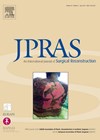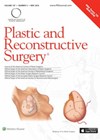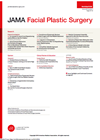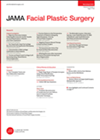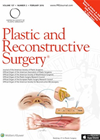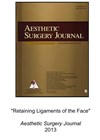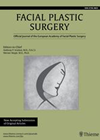
Journal Reviews
Assessment of septal deviation in septorhinoplasty
A variety of methods exist to assess the nasal septum, often dependent of the healthcare resources available, and whether there is a specific pathology affecting the function of the nose. The authors present a small series of patients presenting with...
What is the best graft for nose surgery in the long-term?
The authors of this paper performed an experimental study on long-term histological changes in different grafts implanted subcutaneously in 25 New Zealand white rabbits. Ear cartilage, rib cartilage, autologous fascia, fascia allograft, diced rib and ear cartilage wrapped in autologous...
Impact of lateral crural repositioning on alar rim position
Cephalic orientation of the lower lateral cartilages results in tip fullness, a bulbous tip, and alar instability during inspiration. It has an incidence of approximately 68% in primary and 87% in secondary rhinoplasty patients. Paquet et al. performed the first,...
Patient-related outcomes in rhinoplasty surgery
This paper centres on defining and providing a patient-related outcome tool in rhinoplasty surgery. There are currently no validated tools specifically for cosmetic alteration of the nose alone. The authors devised specific scales within the FACE-Q framework to specifically assess...
Long-term outcome of the Turkish delight graft
The author of this study shows the long-term results of the Surgicel-wrapped diced cartilage, better known by rhinoplasty surgeons as the Turkish delight (TD) graft. The graft, originally described by the author of the article, was meant to be used...
A new method for free-flap total nasal reconstruction
Total nasal reconstruction is a challenge for facial plastic surgeons. Although most cases can be handled with local flaps, a bad state of the perinasal soft tissues, such as patients with head and neck radiotherapy may preclude its use with...
Lateral crura reinforcement with the sandwich technique
Maintaining nasal tip structure and contour is an important goal during rhinoplasty surgery. Tip deformities can occur due to lateral crura malposition, trauma or sometimes due to excess of lateral crura triming during previous surgeries. The consequences of lateral crura...
The initial management of nasal trauma
Nasal trauma and fractures are some of the most prevalent clinical problems in a facial surgery practice. Fractures of the nose are the most common facial fractures and reported to be the third most common fracture of the human skeleton....
Management of post traumatic pseudo-telecanthus
Injuries to the nasal and peri-nasal region are common. Indeed the nasal bones are reported to be the most commonly fractured facial bone. While nasal trauma and deformity are commonly recognised and treated, injuries to adjacent structures are easily missed...
Facial asymmetry in patients with deviated noses
Rhinoplasty of a deviated nose is known to be a challenge of its own kind, especially when patients presenting with a deviated nose are unaware of their underlying facial asymmetry. Patients with a successfully straightened nose, continue to perceive their...
Management of the thick skinned nose
The authors briefly present a surgical pearl that helps addressing the overly thick nasal skin envelope in cosmetic rhinoplasty. In order to optimise cosmetic results in thick-skinned noses, contour enhancement is best achieved by elongating and projecting the skeletal framework...
Skin grafts vs local flaps in reconstruction of nasal defects
Nasal defects commonly are a result of removal of skin lesions. Cosmetic outcomes of local flap reconstructions are commonly accepted to be superior in comparison to skin grafts. However, local flap reconstructions require more adjunctive procedures than single-stage operations based...

